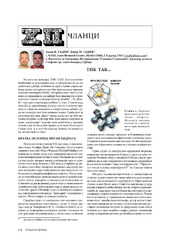Приказ основних података о документу
Tik tak...
Tic-tac
| dc.creator | Tadić, Jovan M. | |
| dc.creator | Tadić, Vojin M. | |
| dc.date.accessioned | 2015-08-28T10:26:51Z | |
| dc.date.available | 2015-08-28T10:26:51Z | |
| dc.date.issued | 2011 | |
| dc.date.issued | 2011 | sr |
| dc.identifier.issn | 0440-6826 | sr |
| dc.identifier.other | Rad_konverzija_448 | sr |
| dc.identifier.uri | https://radar.ibiss.bg.ac.rs/handle/123456789/398 | |
| dc.description.abstract | Jovan M. Tadić, NASA Ames Research Center, USA and Vojin M. Tadić, Institute 'S. Stanković', Belgrade, Serbia The history of methane-hydrate began with accidental experimental findings by Humphry Davy and Michael Faraday in the beginning of 19th century, and somewhat later by Hammerschmith. The recognition of the use of methane- hydrates as a potential energy source is a more recent event, the conciseness about that was developing in the second half, and before the end of 20th century. Methane-hydrates are a sink for methane. Since methane contributes to the overall greenhouse effect by ~10%, its atmospheric concentration has increased 2.5 times since pre-industrial times and that it is 20-25 times more potent greenhouse gas than carbon dioxide it became clear that its exploitation of methane-hydrate is connected with serious ecological risks. It seems that natural deposits of methane-hydrate are already destabilized as a consequence of global warming, and that massive release of methane became common even without the destabilization connected to exploitation. In East Siberian Arctic waters concentrations of methane 100 times higher than usual were found in 2008. Cataclysmic scenario warns that, if this trend is not stopped, enough methane could be released in a very short time to double the greenhouse effect. A whole array of techniques are suggested, commonly named as geoengineering, which are essentially artificial mechanisms to maintain thermal balance on the planet. The most popular are emissions of artificial aerosol which would reflect a portion of sunlight back to space, pumping liquid carbon-dioxide to great ocean depths or deep empty caves, forestation, fertilization of the ocean by iron inducing algae bloom, artificial nucleation of the clouds, etc. Unstoppable development of the civilization and industry implies increasing demand for energy sources that would provide stable supplies in longer periods of time. One of them, for sure, could be natural deposits of methane hydrate. However, before massive exploitation all aspects of such a step should be analyzed very carefully. | en |
| dc.description.sponsorship | null | sr |
| dc.language.iso | srp | sr |
| dc.rights | openAccess | sr |
| dc.source | Hemijski pregled | sr |
| dc.title | Tik tak... | sr |
| dc.title | Tic-tac | en |
| dc.type | article | sr |
| dc.rights.license | ARR | |
| dcterms.abstract | Тадић, Војин М.; Тадић, Јован М.; Тик так...; Тик так...; | |
| dc.citation.issue | 5 | sr |
| dc.citation.volume | 52 | sr |
| dc.citation.spage | 114 | sr |
| dc.citation.epage | 119 | sr |
| dc.type.version | publishedVersion | sr |
| dc.identifier.fulltext | https://radar.ibiss.bg.ac.rs//bitstream/id/2578/Rad_konverzija_448.pdf | |
| dc.citation.rank | M53 | |
| dc.identifier.rcub | https://hdl.handle.net/21.15107/rcub_ibiss_398 |

